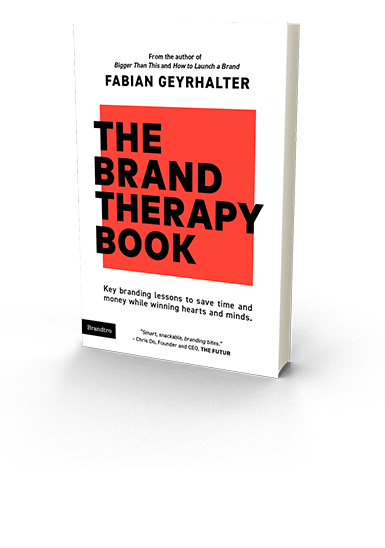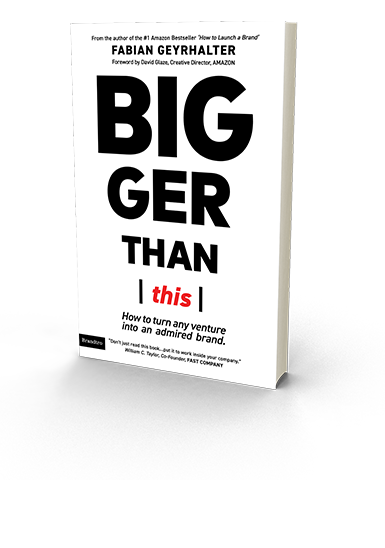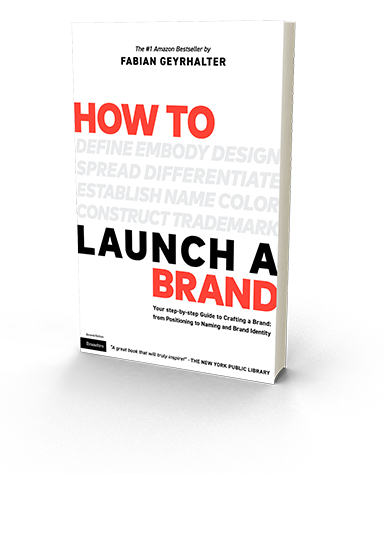Tag Archives: Process
What Is An Entrepreneur’s Biggest Pain Point When Launching A Brand? The Answer May Surprise You.
Working with startups on developing new brands on a daily basis, we had a pretty good idea about our clients’ key struggles, but we reached out to entrepreneurs purchasing our book and asked them what they perceived their biggest hurdles to be. Here are their top 3 pain points:
1. Positioning my new brand (46%)
2. Developing a successful digital presence (21%)
3. Naming the Brand (14%)
Are you surprised?
I was.
Not about the fact that positioning is the most important component of a brand launch. After all, it is the one that takes the most out of entrepreneurs as it requires a refined mixture of many diverse skills – creativity, industry insight, foresight, process and honesty (among others), and it is something that is very hard to create in a silo. What did surprise me was that entrepreneurs see the importance of positioning so clearly and that they are humble enough to acknowledge the DIY approach might not suffice when it comes to this aspect of their brand launch.
Positioning is at the core of brand development, it forces you to answer the question Why, long after the questions What and How have been settled in your mind and you have decided that there was a need and you had the means to start that new business, or create that new product. The direction of the business has been set, but the direction for the brand has yet to be created (and synced). I believe most entrepreneurs start diving into positioning (and the overall creation of the Brand Platform), too far down the line, which adds to the fact that 46% of our respondents see it as their core branding issue.
What is, or was, your biggest pain point with your startup? Do you agree with our readers’ responses?
If you are struggling with positioning, we created a white paper on the subject (free download).
CATEGORIES: Blog Your Brand Launch: Brand Strategy
Building Your Brand From The Ground Up (A Fireside Chat With Yours Truly)
A couple of weeks ago, Bob Garlick, host of Business Book Talk (poking through below), contacted me to schedule an interview about our book ‘How to Launch a Brand.’ With Bob sitting in Vancouver and myself in Los Angeles, I was immediately taken by surprise as there was no script that he shared with me, no canned answers to prep, no warmup chatter and no edits were made to our conversation.

The result is an honest and stimulating conversation between two individuals with a keen interest in design, branding and entrepreneurship, which I’d like to share with you. Below audio not only gives you a peek into our book, but also covers topics such as misconceptions of branding, brand strategy, how brands need to be different than 15 years ago and how to connect with your customers through branding:
Audio clip: Adobe Flash Player (version 9 or above) is required to play this audio clip. Download the latest version here. You also need to have JavaScript enabled in your browser.
(Can’t see above audio player in your E-Mail? Please listen to the audio via our site)
Now that I crossed the bridge by posting audio (how adventurous), I might as well share a quick video in which I further define ‘brand’ specifically for startups, filmed at a mentoring session (how advantageous) at the Founder Institute in San Diego two weeks ago.
The Importance of Branding At Time of Launch For Tech Startup, B2C/Retail And B2B Company Founders
‘Is branding the key for a successful start-up?‘ is the topic for a speech I was asked to give at Internet Hungary this week. I could make it a 5 second speech and say ‘Yes, it is one of the most important factors,’ but lucky for me the topic is broader and will go deeper into the keys of creating a successful brand. Let me use this opportunity though to dive knee deep into this question as some brand elements are more important to certain types of companies at time of launch than to others:
No one shall skip the Brand Platform creation at the onset of a new venture, unless you want to compete on price, be boring and unattractive to work for, and are not keen on acquiring the right target audience at time of launch. You tackle the Brand Platform right after you draft your business plan (from fully fleshed out to napkin version – all are acceptable forms of business plans at this stage, depending on your own comfort level).

Launching with a meaningful and unique Name and Brand Identity Design seems like a no-brainer, a must for all entrepreneurs. If for whatever logical reason (budget not being part of that logic) you feel forced to launch with a sub-par name and logo, knowing you will have to go through a (more costly) re-naming and re-branding exercise upon showing first successes, it is the easiest to do for a tech startup or B2B venture that requires solely test users or relies on a very small niche audience, which will make it easier to educate them on this big and disruptive brand change down the road. Some Tech Startups (especially apps) are prototyping until the day of launch, making it an easy excuse to skip this essential step, whereas it is much more advisable to work on a prototype whilst formulating the brand platform, that way you are educating yourself about the target audience while you see them use the actual product, enabling you to create a meaningful brand that will not have to be rebuild soon thereafter. A win – win.
Needs for Brand Atmosphere Touch Points vary in importance and specifics from company to company with retail and other mainly offline B2C companies leading the list, E-Commerce and Tech Startups surviving off some basic, consistent touch points bundled with heavy E-Marketing template creations, while most B2B brands fall anywhere in-between, depending on their structure and audience. If bootstrap is your motto, these can be rolled out over time, making it essentially more pricey, but allowing you to spread the cost.
It only makes sense that ventures leading with digital need to make UI/UX Design part of their strategic brand implementation. Most companies – B2C/Retail and B2B – rely heavily on brand-centric (responsive) web sites to attract and convert leads of different types. For Online Retailers and Tech Startups where the web site also is the product, the prototyping should be addressed in parallel with the Brand Platform creation as it will educate the branding process as a whole. Some companies are able to save on development costs using existing WordPress templates (and such), but brand will still be key at launch.
To conclude, whenever a startup founder tells me (and they tell me all the time) “I can not afford branding at this early stage of my company formation” I reply with “No, you cannot afford not to brand at this early stage of your company formation. Unless you think a strong brand is worth less at time of sale or IPO than an ugly yet functional prototype.‘ This often marks the end of our conversation, until they call a few weeks later to get started with branding their new venture.
3 Ways to Create a Strong Brand Atmosphere From The Get-Go
Once you have established a solid brand platform, name, and identity design, you are ready to breathe life into your brand by expanding it through tangible materials and experiences. At FINIEN, we call these your Brand Atmosphere® Touch Points. Each company has unique needs in terms of developing branded elements for print, display, digital, and environment.
Regardless of which ones your strategy calls for, remember that all brands should focus on how their Brand Platform is integrated into each touch point through consistency in visual cues and messaging. Seemingly small details in layout and design can have a huge impact on your brand’s cohesiveness and success.
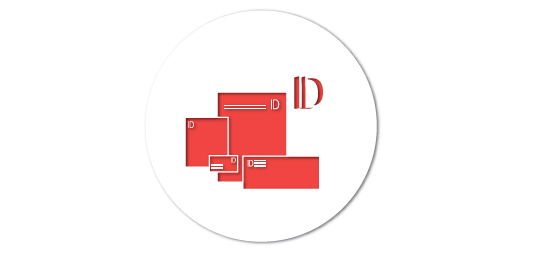
“Design choices like color, layout, and font, can compel the right audience to buy when they are used correctly—or repel your audience from buying when they are not,” states Maria Ross, author of Branding Basics (2010). Furthermore, these design choices will speak volumes about the values of your brand. “Visual expression often reveals the unspoken intentions behind corporate strategy” (2007) confirm both Uli Mayor-johanssen and Klaus-peter Johanssen in World Branding. How do your business cards, storefronts, and social media outlets harmonize to tell a larger story about your brand?
Here are 3 points to pin to your desk (standing desk, I hope!) and to follow religiously when at this stage in your (next) brand launch process:
1. Be Consistent
Cohesive/Holistic/Systematic: Call it what you want. Your brand and all of the elements that make up your brand need to visually speak the same language and communicate the same message. It will make or break a Brand Atmosphere.
2. Be Selective
Don’t try to be on all social media platforms at the outset. Strategize where it is most relevant for your brand to exist and apply a cohesive look-and-feel and brand voice to those channels first. You can always expand to other channels as time allows and needs arise. Also focus on only a few select traditional marketing pieces to get your brand started. Ensure that these pieces communicate the essence of your brand and are well designed.
3. Do Sweat the Details
Each touch point associated with your brand has the power to diminish or enhance your Brand Atmosphere. Never rush through creating your touch points, and do sweat the small stuff.
Adapted from our bestselling book “How To Launch a Brand.”
CATEGORIES: Your Brand Launch: Brand Atmosphere
How Do You Measure Brand & Design ROI On A New Brand Launch?
We get asked this question a lot. The simple answer is: You can’t. Will a strategic and design-driven brand launch generate ROI? Definitely. As you have no before/after metrics and are dealing with a new, often innovative and disruptive brand, this is a tough nut to crack.
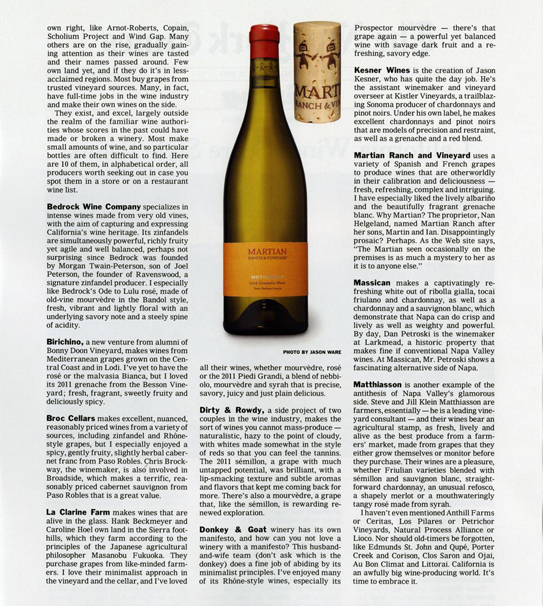
Yesterday, FINIEN client Martian Ranch & Vineyard sent us above reprint of a New York Times article that ran a couple of weeks ago, entitled “California Wines Score Style Points.” We were grateful and proud of our collaborative achievements. Their wines are truly other worldly so it comes as no surprise that the winery receives praise on the highest media levels. But as one of ten featured wineries, their product is the one that has been picked by the editors to be featured with a rather large photo of the product packaging, including…the cork.
Now that is true ROI on a strategic and design driven brand launch. Seeing the wine brand rather than just reading about it creates immediate product recognition, leading to impulse buys and elevated brand perception. Most wineries make their branding effort the last agenda item with the smallest piece of the overall budget left over and they wing it days prior to bottling their wines. Martian hired us to create a brand with a focus on product packaging that stands out on the shelves and has a cohesive brand story to tell that is unique and interesting.
It showed…and now it sells.
CATEGORIES: Blog Your Brand Launch: Brand Atmosphere
The top 5 must-do’s for your tech startup brand launch
![]() Jason Calacanis, founder of Silicon Alley Reporter, Engadget, TechCrunch 50, LAUNCH, This Week in Startups as well as his new venture, Inside.com, asked me ‘What are the most important things you’ve learned about launching?‘ Here is what I wrote him:
Jason Calacanis, founder of Silicon Alley Reporter, Engadget, TechCrunch 50, LAUNCH, This Week in Startups as well as his new venture, Inside.com, asked me ‘What are the most important things you’ve learned about launching?‘ Here is what I wrote him:
1. PICK A PROCESS
There are many processes to launching your tech startup. Choose one that works for your personality, budget and within the culture you are about to create.
2. TEST AND FAIL
Test and fail and test and fail. You should invest in creating your brand only once you really understand your target audience’s behavior and true needs.
3. LAUNCH AS A BRAND
Launch as a brand, not a startup that may develop into a brand. Launch by design. Design relates to the process you have to adhere to, but furthermore it truly is design that holds the key to early brand success. Graphic design, brand identity design, and web design will set your offering apart at the time of launch.
4. TAKE NAMING SERIOUSLY
Naming is crucial. You can’t change the name of your kid once they are in puberty. The name you choose at launch will remain with the brand forever, so don’t settle for a placeholder name that just happened to make it into beta because the domain was available. It’s an art, science, and legal matter, so make sure it doesn’t get overlooked.
5. LISTEN SELECTIVELY
‘Opinions are like @**holes, everybody has one‘ – choose wisely whom you listen to, which opinions you implement, whom you exclude from certain conversations and why. Have a ‘stakeholder opinion plan‘ in place from the start to make it easy for you to adhere to and eliminate the unease of hurting people’s feelings or having to re-do certain phases of your project because you did not listen to the right people at the right time.

